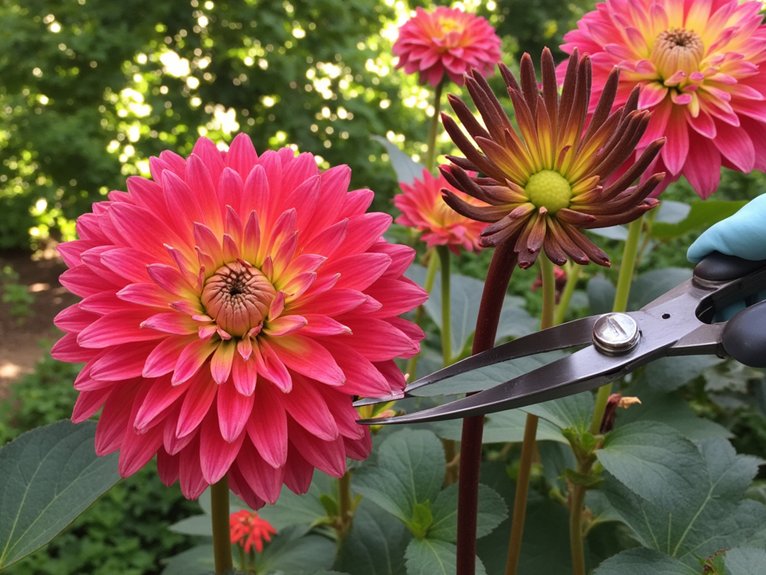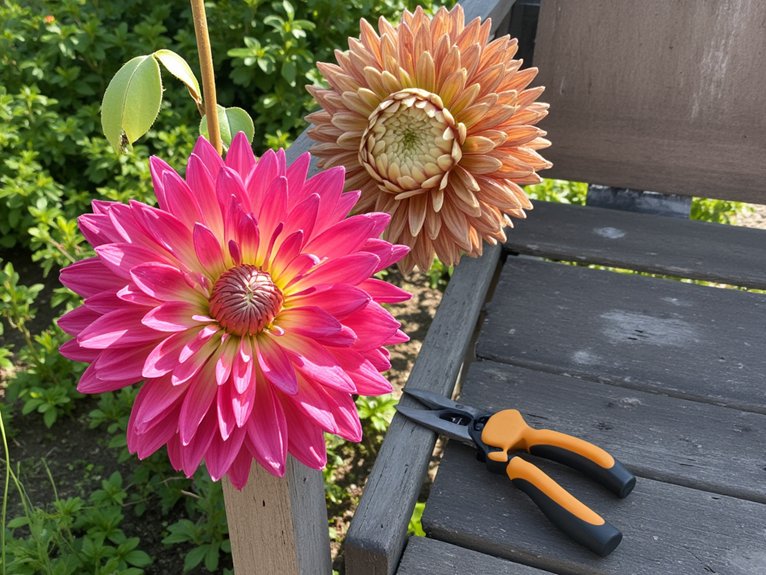Deadheading dahlias requires more finesse than simply snipping off spent blooms. Master gardeners emphasize that proper technique and timing can double or triple a plant’s flowering season. “The key lies in understanding where and when to make your cuts,” explains horticulturist Sarah Chen. While basic pruning might seem straightforward, the subtle details of dahlia deadheading can transform an average garden into a spectacular display of continuous blooms. The process involves specific tools, precise timing, and strategic cutting points.
Contents
Understanding the Basics of Dahlia Deadheading

Deadheading dahlias represents a fundamental maintenance practice that every gardener should master to maximize these stunning flowers’ blooming potential. This process involves removing spent blooms before they go to seed, redirecting the plant’s energy into producing new flowers rather than seeds.
For peak dahlia growth across all flower varieties, from tiny pompoms to giant dinner-plate blooms, gardeners should inspect plants weekly during the growing season. The process requires identifying faded flowers, which appear droopy and lose their vivid coloring. By making clean cuts just above the first set of leaves, gardeners encourage robust branching and continuous flowering throughout the season.
Essential Tools and Timing for Success
Several essential tools and proper timing make the difference between mediocre and exceptional dahlia maintenance results. Successful deadheading techniques require sharp pruning shears, clean garden scissors, and protective gloves. A dedicated collection bucket helps maintain garden tidiness.
Seasonal timing plays a significant role in dahlia care. Begin deadheading when the first blooms fade, typically 2-3 weeks after initial flowering. Continue the practice weekly throughout summer, but cease deadheading six weeks before the first frost to allow plants to prepare for dormancy.
For precision cuts, sterilize tools with rubbing alcohol between uses to prevent disease spread.
Step-by-Step Guide to Perfect Deadheading

With the right tools in hand, mastering the proper deadheading technique guarantees abundant dahlia blooms throughout the growing season. Follow these essential deadheading techniques:
- Locate spent blooms by identifying conical, faded flower heads
- Position clean pruning shears at a 45-degree angle
- Cut the stem just above the first set of healthy leaves
- Remove entire flower head and stem to encourage new growth
Regular flower maintenance assures continuous blooming. “Cut cleanly through stems rather than crushing them,” advises professional gardener Sarah Chen. “This prevents disease and promotes faster regeneration.” Remove debris promptly to maintain garden hygiene and prevent fungal issues.
Common Mistakes to Avoid When Deadheading
While enthusiastic gardeners may keenly trim their dahlias, making mistakes during deadheading can harm plant health and reduce blooming potential. Common errors include cutting too close to the main stem, removing healthy buds mistaken for spent blooms, and following deadheading myths about timing.
Gardeners should avoid cutting below leaf nodes, which can create vulnerable entry points for disease. Another frequent mistake is deadheading during late fall when plants naturally prepare for dormancy. Instead, leave the final blooms to help guide spring pruning locations.
Proper technique requires identifying truly spent blooms and making clean cuts just above leaf joints or developing side shoots.
Maximizing Blooms Through Proper Maintenance

Proper maintenance routines transform ordinary dahlia plantings into spectacular flowering displays throughout the growing season. Regular deadheading, coupled with consistent watering and fertilizing, greatly increases bloom frequency. Experienced gardeners remove spent flowers weekly while checking for signs of pest damage or disease.
To maximize blooms, implement these essential seasonal care practices:
- Water deeply at soil level, avoiding foliage
- Apply balanced fertilizer monthly
- Stake tall varieties early in the season
- Mulch to retain moisture and suppress weeds
- Monitor for insects and remove affected leaves promptly
- Maintain 6-8 inches of space between plants
